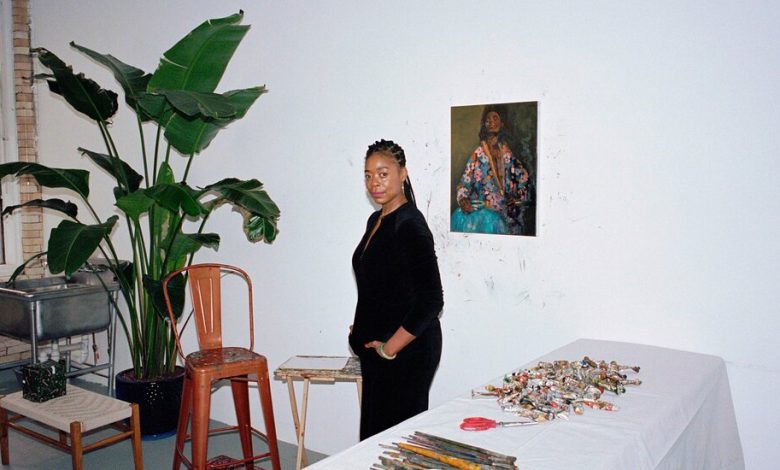Danielle Mckinney Never Thought Her Paintings Would Be Seen Like This

THE SUBJECTS OF Danielle Mckinney’s paintings are exclusively Black women, like the artist herself. They are generally posed inside darkly lit but nevertheless inviting domestic spaces. The effect is both casual and courtly: Her women lounge on couches and read magazines. They smoke gracefully but with what Mckinney, 42, described as “a worldly tension.” In person, she shares a kind of understated glamour with her subjects, and she paints the act of smoking with nostalgia and envy. She started smoking when she was 13; when I first visited her Jersey City, N.J., studio last April, she was trying not to fall off the wagon. “After the last one, it’s been 70 days,” she said. “But I had two in between there.”
Her paintings are small and, as more and more people have seen them — something that’s been known to make other painters’ work expand in tandem with their egos — they’ve only gotten smaller, often not much larger than a sheet of notebook paper. She uses a richly textured oil, a more stubborn material than acrylic, which dries faster and is easier to control. And whereas most painters favor white gesso to prepare a canvas, Mckinney chooses an almost counterintuitive layer of black. Her figures seem to emerge out of shadows, like a photograph being developed.
transcript
My Favorite Song | Danielle Mckinney
The artist discusses Sade’s 1992 song “Kiss of Life.”
My name is Danielle Mckinney. I’m a visual artist, and my favorite song is “Kiss of Life” by Sade. [TRANQUIL MUSIC] What I love about Sade is that she’s a very private person. You don’t hear about her in the news. She comes out with a big, loud voice, a powerful female voice, and then she goes back in herself. And that’s something I respect about her. It’s something that I also carry through in my paintings. They are these strong, beautiful Black females, but then they go back into their spaces, you know? Sade got me through moving here from the South to New York and not knowing a soul. I turned her on in the subways. Sade was the first sound of music for me as a child when I was eight years old. Saturday mornings, my mom would let me sleep in, but she would always have the music on. And so I would wake up always because the radio station in Alabama played the same songs. So “Kiss of Life” was my first understanding of music and sound. When I’m in my studio, and I’m stuck with ideas, and I don’t know what to paint, I turn her on and close my eyes and go back to this soothing moment of home. It’s like the paintings need that sound to kind of move the paint. Sade got me through the birth of my first child. I remember being in the hospital, and I was so nervous. And all I needed was something to just calm me down. And I looked at my husband. I said, “Turn on Sade.” I immediately calmed down. And within 30 minutes, the baby was there. But I needed the voice. I needed the sound of Sade just to soothe me, to bring me back home. So I hope she hears this because I love her. [SADE, “KISS OF LIFE”]: “The color of love.” [CHUCKLES]: I know. I love her. I love her so much.

The artist discusses Sade’s 1992 song “Kiss of Life.”CreditCredit…Jordan Taylor Fuller
The women she paints are imagined — unlike many portrait painters, she doesn’t have models sit for her — but she refers to her paintings as “my babies,” and talks of her subjects as if they were trusted friends. “They smoke for me,” she said. When one of her paintings — “We Need to Talk,” a 2020 portrait of a woman in a white dress collapsed on a bed with her black cat looking on — went up for auction at Christie’s in New York last May, Mckinney was stressed out by having to watch something she made become such a commodity. She cried, then smoked an entire pack of Marlboro Reds. She came to terms with the sale a week later, when the couple who purchased the work attended the opening of her second solo show at Night Gallery in Los Angeles. “We’re so happy to have her,” they reassured her. “Come visit her anytime you want.”
Being in this kind of demand is untested territory for Mckinney. When 2020 began, she was living in New Jersey, just on the other side of the Holland Tunnel from New York City, with her husband, Robert Roest, who’s Dutch and also a painter, and working full time as a manager of course planning in the architecture program at the Parsons School of Design in Lower Manhattan. Seven years earlier, Mckinney had completed an M.F.A. in photography at Parsons, a degree for which she was still paying off loans. Her mother gave Mckinney her first camera when she was 15. Her art, she’d say, was about “watching people look.” She shot one series during her morning commute, asking fellow subway riders if she could touch them, and photographing their reactions.

The artist’s 2023 painting “Shelter.”Credit…© Danielle Mckinney. Courtesy of the artist, Marianne Boesky Gallery, New York and Aspen. Photo: Nik Massey
